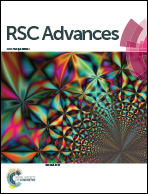Tuned synthesis of doped rare-earth orthovanadates for enhanced luminescence†
Abstract
Lanthanide orthovanadates of appropriate morphology, polymorph character and size are attractive for various electronic and magnetic applications. Though template free methods exist, there is a preference to facile template based methods for fine tuning of shape and size. The novelty of the methodology reported herein is the use of a biologically acceptable chelate such as catechin (5,7,3′,4′-tetrahydroxyflavan-3-ol for a selective synthesis of tetragonal LaVO4 over the preferred monoclinic phase) in a short duration of time. Optimal conditions ([cat4−]/[La3+] = 1/20; T = 210 °C for 4 h and pH 7) for the synthesis of t-LaVO4 (JCPDS no. 10-705226) with a crystal size of around 16 nm have been established. Our experiments on the role of pH in the formative steps of the complex indicated that catechin serves not only as a polymorph controller but it also aids in shape selection. Under optimal synthesis conditions, a switch over from isotropic to anisotropic structure was brought about by a pH change from 5 to 7. The process methodology has been tuned to ensure that the drawbacks associated with template based methods, viz., the presence of template impurities, have been significantly overcome. From CHN analysis and FTIR measurements, less than 2% carbon from catechin is found to coat the nanoparticle surfaces, which contributed to prevention of aggregation. Extending the work further, Gd3+ doped t-LaVO4 was also synthesized to obtain luminescent and magnetic properties (fluorescence lifetime of 0.2 ms and magnetization of 0.79 emu g−1 at RT), which are possibly ideal for imaging applications, such as for T1 contrast agents for MRI.


 Please wait while we load your content...
Please wait while we load your content...